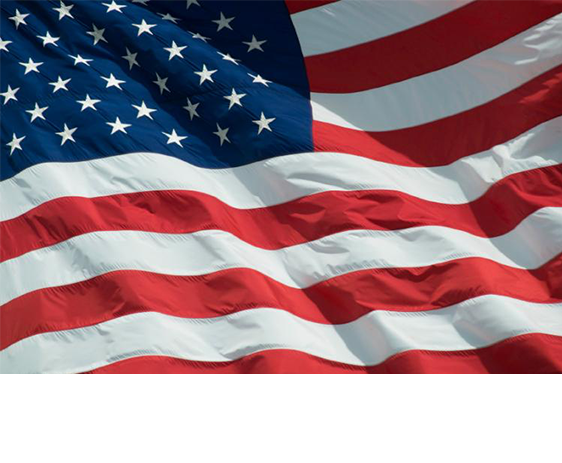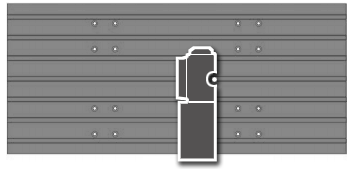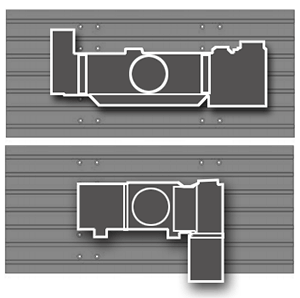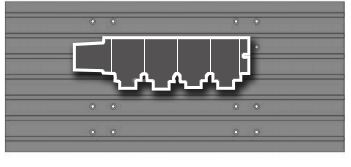Warning: Do Not Read This Story!
READER BEWARE: EXPLICIT CONTENT
Jesse James is a lot of things, but politically correct is not one of them. He is what he is, and he does what he does . . . and he really doesn’t give a damn what anybody thinks about it. He is the quintessential outlaw biker, and he plays by his own rules.
Lately, Jesse’s badass attitude and rebellious persona have gotten lots of attention, thanks in no small part to his current gig as frontman for the Discovery Channel’s hit series Monster Garage. The popularity of the show, in fact, has elevated the 34-year-old James to near rock-star status. People magazine even dubbed him one of the sexiest men alive recently – further proof of his celebrity. No longer does the name Jesse James elicit images of a gun totin’, horseback ridin’, Wild-West bandit. Rather, it brings to mind a chopper ridin’, blowtorch wieldin’, West Coast biker with slicked-back hair and tattoos.
Despite his recent popularity, though, Jesse still considers himself “a glorified welder.” Prior to his Discovery by the world of cable TV, he was just another custom-bike builder, plying his trade from his shop in Long Beach. Of course, the fact that his shop encompasses 18,000 square feet of showroom, offices, machine shop and manufacturing area, and that there’s a serious waiting list for one of his bikes, says there’s more to the man than just a pretty face, especially when you consider he started out in the corner of his mom’s garage.
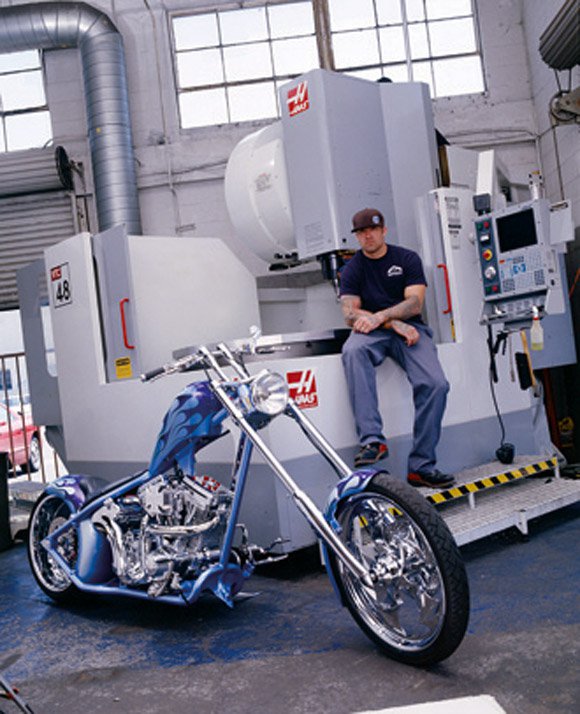
Jesse James is a skilled craftsman who sculpts two-wheeled works of art for the likes of Shaquille O’Neal, Kid Rock, Keanu Reeves and anyone else who can pony up the $50,000 to $150,000 asking price for one of his creations. [Well, almost anyone. Word is, if you piss Jesse off, or if he just doesn’t like you, no amount of money will get him to build a bike for you.] His company, West Coast Choppers, rakes in an estimated $6 million in annual revenues – 60% of which is generated by the company’s clothing line. It seems everyone wants to be a biker these days, or at least look like one. And for a mere 24 bucks, anyone can show off their outlaw tendencies with an original West Coast Choppers Iron Cross T-shirt.
Jesse’s own outlaw tendencies surfaced at an early age. The fact that his great-great-grandfather was the infamous bandit’s cousin probably had something to do with it. “I guess it’s kind of in my blood,” he says. “I just do whatever I want, and don’t usually do what too many people say.” [Interestingly enough, if you compare pictures of the two men side by side, there’s a distinct family resemblance.]
Growing up with such a legendary name understandably brought with it in a certain level of abuse. “There was always teasing and shit, like, the first day of school,” Jesse explains. “Whenever they read off your name, you know? Shit like that.”
Jesse’s parents split up when he was five, and he lived with his dad, who owned an antiques business. “He was busy workin’, so I was by myself a lot,” Jesse notes. “So, naturally, if there’s no parent around, you’re going to do whatever, and learn right and wrong the hard way. And that’s exactly what happened.”
But some things are worth getting in trouble for.
His dad’s antiques business happened to be next to Performance Machine, a company that manufactured aftermarket brakes and accessories for Harley-Davidsons and other motorcycles. The young Jesse found himself inexplicably drawn to the bikes and machinery next door. He would sneak into the machine shop and watch as the lathes and mills transformed chunks of metal into motorcycle parts.
“My early, early memories are going next door and playing with all the metal chips, and seeing those guys,”
Jesse says. “They had, like, metalflake fucking trikes and flashy choppers and stuff like that. I was like four or five years old when I was around that. I don’t even remember the inside of my dad’s shop, but I can remember what it looked like inside Perry’s shop [Performance Machine], and where the machines were laid out, and stuff like that. And the smell, you know? Cutting oil and stuff like that.”
By the age of 7, Jesse had a motorcycle of his own: a Kawasaki 50cc mini bike. It wasn’t much, but it had two wheels and an engine. “That’s the first bike I had,” he says, “and I used to ride it every day after school. I’d use, like, almost two tanks of gas every day . . . I probably shoulda been doing homework.”
That’s not to say Jesse didn’t do homework – he just did homework of a different sort. By 9, he was already developing his fabrication and marketing skills. He took an old 1940s Schwinn Straight Bar bicycle, customized it, added new chrome and pinstriping, and then sold it at an antiques show for a considerable profit.
Jesse continued his habit of learning things the hard way throughout his teens. He readily admits to having a “fondness for other people’s stuff,” which led to frequent visits by the local constabulary, and three all-expenses-paid “vacations” courtesy of the California Youth Authority.
Unlike his namesake, though, who continued his life of crime until he was murdered by a member of his own gang at the age of 34, the modern-day Jesse James saw the error of his ways before it was too late.
“When I turned 18,” Jesse says, “this, like, automatic alarm clock went off in my head: Okay, quit @#$%&*’ around now. If you flush it now, you’re going to go to big-boy jail, you know, and it’s going to end up on your record. Your hall pass is over.”
But walking the straight and narrow didn’t mean Jesse had to conform. “When I was in high school, I was kind of a loner,” he says. “I hated everybody and everybody hated me, and I built a big, loud, obnoxious bike just to make ’em hate me more – you know, the administration at the high school, and stuff like that. ”
And that first bike is where it all started.
According to Jesse, he always wanted expensive bikes when he was in high school, but he didn’t have any money (like most teenagers, he had a bit of a cash-flow problem). But the lack of funds didn’t stop him from wanting a cool ride. He built a chopper – a rigid-framed bike that’s all trimmed down – because it was all he could afford. And the only way he could afford that was by doing everything – the bodywork, the paint, the engine – himself.
The finished project soundly met Jesse’s primary requirements: It was loud and obnoxious, which satisfied his desire to piss off the administration, and it scored pretty high on the cool meter – his friends couldn’t believe he’d built it himself.
Jesse continued honing his skills after high school, building bikes for himself and for friends. He was still working out of his mother’s garage when he coined the name for his future business around 1988. It happened while he and a buddy – “We went to school together since the fourth grade,” says Jesse – were gearing up for the Laughlin River Run.
“I came up with the name West Coast Choppers,” Jesse explains, “and he drew the first logo, which is actually the logo we have now. We made some T-shirts – I think we made, like, 10; we couldn’t afford a full dozen, so we made 10 – then we rode to the Laughlin River Run. I gave them to all my friends, and they’re like ‘What the hell is this?’ I’m like, I swear, trust me, this is my shop. And they’re like, ‘You don’t have a shop. What are you talkin’ about? You work in your garage.’
“I think, out of those 10, I passed out only, like, three – three of my friends wore them . . . reluctantly. And, you know, I kind of knew: Even though I had a good job doing something else, working for other places, I always knew that West Coast Choppers was gonna be it. That was my dream.”
But dreams don’t pay the bills. Jesse trained to become a professional bodyguard, and over the next several years, he traveled the country as hired muscle for such big-name bands as Soundgarden, Slayer and Danzig. He continued building bikes between gigs.
He was making good money as a bodyguard, but motorcycles remained his passion. After sustaining a dislocated elbow during a concert in Detroit, Jesse decided to give up his career as a bodyguard and pursue his dream of having his own shop.
Unlike most people who start a new business, Jesse refused to take out a loan or solicit investors to finance his venture. “I think a lot of people, you know, their business plan is to get a loan, and get a bunch of money, and buy a bunch of shit,” says Jesse. “Then, when it dies, they’re like, ‘What the fuck happened?’ They never figure in themselves working hard and sacrificing their own time and profits.”
Jesse’s business plan was much simpler: work hard, stay out of debt, re-invest profits back into the company and, most importantly, soak up all the knowledge he could about metalworking and building bikes. “I’m kind of like a sponge,” he says. “I want to learn everything I can from everyone.”
For his education, Jesse sought out some of the top names in the industry, including master metalsmith Fay Butler, custom hot-rod builder Boyd Coddington and Ron Simms, owner of Simms Custom Cycles. It was a mix of old-school hand-fabrication methods and modern machining techniques. Jesse worked with Boyd for about two years before going out on his own.
West Coast Choppers became a reality in 1992. It wasn’t long before Jesse couldn’t fit everything in his garage anymore, so he rented the corner of a friend’s building. When that wasn’t enough, he moved to a 3,000-square-foot building of his own. As West Coast Choppers continued to grow, Jesse stayed true to his business plan, always working hard and pumping every dime back into the company. “Whenever I sold a bike,” he says, “I took the profit and put it back into the business, or bought another sheet metal machine, or tooling, or whatever, you know.”
Those investments paid off. West Coast Choppers developed a loyal following of fans and customers, and Jesse’s bikes started getting serious play in the biker mags. But it wasn’t until 2001 that Jesse got his first mainstream exposure, when the Discovery Channel aired a pair of specials – Motorcycle Mania I and Motorcycle Mania II – documenting the inner workings of West Coast Choppers. It was the world’s first glimpse of this modern-day outlaw – and apparently the world liked what it saw. The extreme popularity of those shows – Motorcycle Mania II was the highest-rated show in Discovery Channel history – in turn led to Jesse’s current stint hosting Monster Garage.
Despite his new celebrity status, and the demands placed on him by Monster Garage, Jesse is still very hands-on when it comes to building custom bikes and designing new products. “People are paying a premium price for a Jesse James bike,” he explains. “Jesse James should be making some of it, right? I’ve got a whole row of bikes that are lined up and waiting for me to make tanks and fenders and exhaust systems for them.”
When Jesse builds a custom bike, he wants it to be a reflection of the person who ordered it. He refuses to duplicate what he’s already done for someone else. He spends time with the customer to find out what they like, and what they don’t like. Once he’s got a feel for what the customer is trying to achieve with the bike, he moves on to the design process.
Not everything West Coast Chopper produces is custom, though. The company also manufactures three production frames, several exhaust systems, an assortment of front and rear fenders, and myriad aftermarket accessories, such as air cleaners, belt guards, pulley covers, kickstands and handlebars.
While the wait for one of Jesse’s hand-built customs (if you make the list) is around a year – each one takes 500 to 800 man-hours to build – the production bits are available off the shelf, for those do-it-yourselfers who prefer to, well, do it themselves. Like the customs, the production parts are manufactured in-house to ensure everything meets Jesse’s exacting standards.
The manufacturing side of West Coast Choppers is a unique blend of old-world metalworking and high-precision CNC machining. Vintage Yoder power hammers, bandsaws and drill presses sit just a stone’s throw from modern Haas CNC machining centers and lathes.
Sheet metal and tubing for fenders, tanks and exhaust systems are painstakingly shaped by hand and sculpted to fit perfectly. Frames are carefully assembled and meticulously welded. Power hammers, grinders and saws produce a constant deafening roar. At the same time, the Haas CNC machines are busy churning out all of the components that require precision machining.
“Most people in the industry use flame-cut, plasma-cut bullshit,” says Jesse. “Every part on our bikes that isn’t hand fabricated is CNC machined – all the brackets, all the engine mounts, everything. You know, it’s a lot more expensive to do it that way, but the quality’s better. It makes a better end product. I think a bike should be fifty-fifty: fifty percent programmed and fifty percent made by hand. And I think if you can blend that mix, it’s perfect.”
Jesse didn’t always feel that way about CNC, though. “I was resistant to it at first,” he says. “I could run a Bridgeport really well, you know, turning both cranks at the same time [to create curves]. Some Swedish guys at Boyd’s taught me how to do that, and I thought, Well, shit, I could just make that. But you can’t; as much as you think you can, you can’t. There’s just some stuff that, you know, you can whittle on a manual mill and make by hand, but it’s really not going to be the same. You’re not going to get the nice curves, and perfectly indexed holes, and stuff that you can on the CNC.
“Working for Boyd [Coddington] kind of helped me understand how the CNC works – what it will do, what it won’t do – which I don’t think a lot of people understand,” says Jesse. “And that’s helped me to make cooler stuff.”
Jesse also learned that buying used equipment could be more hassle than it was worth. “He [Boyd] always bought used machines and got a deal on them,” Jesse explains, “but he was always fucking with them – all the time. You know, this one was down, that one was down. I’m like, You know what? I just want a new one that I can just make shit with and not have to worry about it.”
The first CNC at West Coast Choppers was installed in 1998: a Haas VF-3 vertical machining center. That was followed by an SL-30 turning center in ’99, a second VF-3 in 2000 and a VTC-48 vertical turning center in 2003. Jesse went with Haas, he says, “because they were a pretty good deal, and they’re versatile, and if something goes wrong, you guys are, like, right there. They’ve been really dependable; they’re workhorses.”
Jesse knows how to run the machines, and has a bit of programming experience, but he’s really more of a sheet metal guy and a welder. The CNC programming duties at West Coast Choppers are handled by Michael Warth, a skilled machinist with 18 years of experience running machines, and 12 years of experience programming them. His background is predominantly aerospace work – “I made C-17 parts, mainly,” he says – with a heavy emphasis on 5-axis work prior to joining the crew at WCC.
Warth left aerospace because he was “aggravated with the 5-axis programming job,” he says. “My boss didn’t understand what was involved in it.” He actually turned down the job at West Coast Choppers at first. “I was going to take another job,” he explains, “and Jesse called me in on a Saturday and talked to me, and he says, ‘Look, I really need you here; I need somebody that can do what you can do.’ Okay, we’ll try it. The rest is history; here I am.”
It’s proved to be a good decision on both sides. “It’s a lot more relaxed here,” says Warth. “It’s a situation where I decide what is the best way to approach something, and how to design something. Whereas, in aerospace, you have a blueprint that gives you specifications that you have to hold. It’s really fluid around here; you never know what you’re going to get.”
Which is exactly how Jesse likes it: “What we do mixes my skills, which are predominantly as a fabricator, with Mike’s skills as a CNC guy, and blends them together.”
The thing is, Jesse doesn’t like his machined parts to look like machined parts – “I hate that ’80s-lookin’ billet stuff,” he says. He wants them to look like they’re sculpted out of metal, with smooth curves and complex shapes, and polished to a mirror shine.
And that’s where Warth’s skills as a programmer and an engineer come in. “Jesse will give me an idea – ‘I want something that looks kind of like this’ – and I have to look at what he wants and decide what’s realistic,” Warth says. “I try to get as close as I can between the artistic approach and the realistic approach. I have to try to bring the two things together and merge them into one.”
Sometimes Jesse’s ideas come to Warth in rather unusual forms.
“Usually, if Jesse draws it,” says Warth, “it’s just a rough sketch on whatever paper is available. I’ve gotten things drawn in black marker on a cocktail napkin. Sometimes he draws right on the tables out here, and I have to go out and look at the table, and then go back to the computer and design it . . . ’cause I don’t have it on paper!” he exclaims.
Just because something looks bitchin’ on paper, though, doesn’t mean it will work in the real world – the laws of physics still apply. “If it’s not strong enough,” says Warth, “it will buckle and fold if we put it on a bike.”
Warth’s job is to make sure that doesn’t happen, and his aerospace background and materials experience play a key role. “I work formulas out of the Machinist’s Handbook, based on material strengths,” he says. “I have an idea of how much horsepower comes out of one of these motors, how you can transfer it through the drive, and I just run it through the formulas. I make sure that I’ve got enough material and enough strength there to do what I think it’s going to do, plus a margin of error.”
“That’s where knowing what the machines will do and won’t do comes in,” adds Jesse. “And having a clear knowledge of what the tool paths are. He and I go back and forth with dimensions and stuff like that.”
Warth designs primarily in MasterCam, but uses SolidWorks for the more complex parts, such as wheels, or when designing linkages and assemblies. “In SolidWorks, you can build a whole assembly and make sure that everything moves the way it should,” he explains. “The real simple production brackets and things like that, I won’t mess with the solid, I’ll just create a wireframe profile and derive a program and be done with it. All of the wheels, though, I design in solid, because solids are easier to deal with, as far as manipulation of the shape.
“I probably do more one-off stuff than I do production,” Warth continues, “because once I do a production thing, it runs and runs and runs, and I don’t have to deal with it anymore. So, I spend probably 80% of my time designing and doing one-off parts.”
Once the programs are written, they’re downloaded to the Haas machines via Ethernet (except the lathe, which uses RS-232, because the programs are so small).
“The Ethernet cards are great,” says Warth, “because I don’t have to stop what I’m doing. The operators can get everything they want, whenever they want it. It’s a lot less headache for everybody. They can pull the files right off my computer.”
Having been on the receiving end of questionable programming, Warth is very conscientious about what he gives the guys who run the machines. “I’ve worked for programmers where you were scared to death to push the button, ’cause you didn’t know what it was going to do. I try to keep that in mind when I write programs,” Warth says. “These guys down here on the floor don’t have to worry too much about it. They put the part on, they load my program and they run it. I think in two years, I’ve scrapped one part.”
That’s a good thing, because Jesse is always pushing the envelope with his designs and with what he wants to do with the machines. His latest project is machining some very unique wheels.
“Jesse, he likes to do things that nobody else does,” notes Warth, “and for one of his bikes, he decided he wanted some wheels out of solid billet.”
“They’re carved from a solid aluminum block,” says Jesse. “Fifty-eight hours of machine time.”
“Nobody in the world makes solid billet wheels,” Warth continues, “because of the cost. They’re incredibly expensive before we even start.”
At the time, West Coast Choppers didn’t have the machining capability to turn the large chunks of aluminum, so they had to send the material to an outside shop for the lathe work. The results were disastrous.
“We started with two sets of material, enough for front and rear wheels for two bikes, and they messed both the front wheels up, and they didn’t tell us,” says Warth. “They blew the lathe work, and then laid this weld bead all the way around and re-machined it. When we had the wheels anodized, it showed up.”
Considering the wheels were for a prototype concept bike for Honda, Jesse was not pleased. He told Warth to find a machine that would allow them to do the wheels completely in-house.
“We already had the Haas, so I started looking at Haas machines,” says Warth. “Going through the catalog, I saw the VTC [the Haas vertical turning center, which has a 48″ rotating platter and 50-taper live tooling], and I said: That’s the machine we want right there. It will do the turning work, plus we can come in and machine it in the same rig. We don’t have to move the part.” The Haas VTC was installed in April of 2003.
The machining processes for the wheels differ slightly, depending on whether it’s a front or a rear wheel. The rear wheel starts out as a 550-pound block of aluminum, and the material for the front wheel weighs in at about 330 pounds. The finished weight of the rear is about 58 pounds, and the front comes in around 48 pounds. “They’re still pretty heavy,” says Warth, “because of the shape and the profile we have. It’s solid, and it’s almost enclosed.”
The front wheel is by far the easier of the two to machine. Everything is done using the 50-taper live tooling on the VTC. “Because I don’t have to go that deep,” Warth explains, “I can go with the live tooling, and I can machine that thing into a round – five-thousand rpm and we just go to town with it.
“The rear wheel, I’ve got eleven-and-a-half-inch stock,” he says. “Try to mill eleven and a half inches deep!
It doesn’t work too well. So I go into turning on the rear wheel. I come in with an OD turning tool, and I just step it and turn it down to the diameter I want. It takes a hundred steps – a hundred cuts – to get there, but it does it great. Two hundred rpm, five thou’ per rev – it takes a day, a day and a half, just to do the rough turning.”
The wheels are rough machined first, and then sent out for heat treatment and stress relief. Then they’re finish machined and polished.
Cycle times are measured in days, rather than hours. “The rear wheel – to machine one complete out of square material like we do – takes about 8 days on the machine,” says Warth. “The front wheel takes about 5 days. It depends on the amount of 3D, and the amount of detail, but the style that we’re running right now, that’s about what they run.”
Although the VTC is a turning center, Warth prefers to use a mill post-processor for his programming; he makes extensive use of the Cartesian-to-polar interpolation feature of the Haas control. “It converts a standard X,Y program into X and rotary,” Warth explains. “It converts it on the fly in the machine; I run that all the time. So that’s a great feature for me, ’cause all I have to do is post it a little bit differently. I modified the mill post a little bit to put the codes out the way I wanted it to. It works great.”
Don’t plan on seeing a production version of the billet wheels any time soon, though. Jesse has no interest in high-volume manufacturing. “We make a few sets of each style, and then go on to something else,” Jesse says. “I want to keep them cool, so I only make a couple of them. It just separates us that much farther, you know. I mean, there’s not too many shops that are gonna want to put twenty-five-thousand-dollar wheels on a bike . . . but I will.”
One of the definitions of the word outlaw is a person who refuses to be governed by the established rules or practices of any group: a rebel; a non-conformist. That pretty much sums up Jesse James, and it seems to be working for him. The success of West Coast Choppers is undeniable. The company is bursting the walls of the 18,000-square-foot building that has been its home since 1998, and business couldn’t be better. And Jesse recently closed the deal on the 50,000-square-foot building across the street, so space won’t be a problem much longer. “We’re just going to split it up so everybody’s got more space to work,” he says. “And I’m moving my office, and my shop, and all my power hammers and fab stuff across the street . . . so I can be away from everybody and be by myself again.”
Sounds like he’s heading back to his roots . . . except this time, he’ll be in the corner of a much larger garage.


